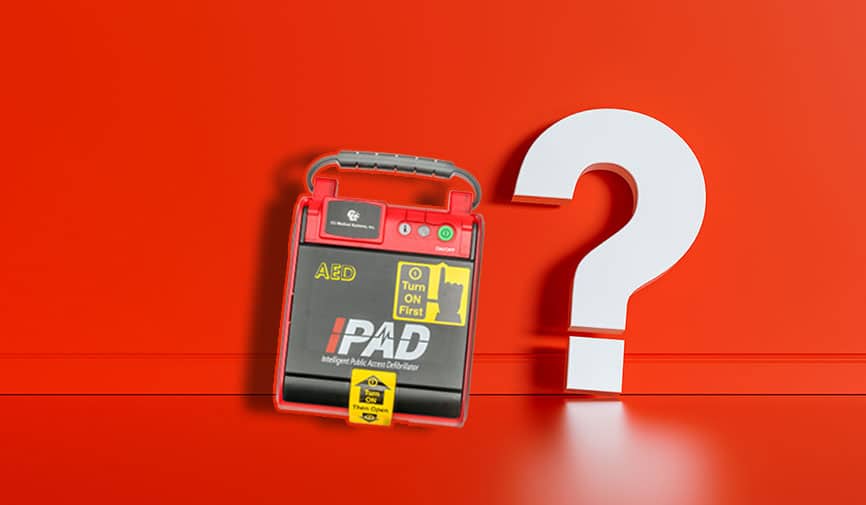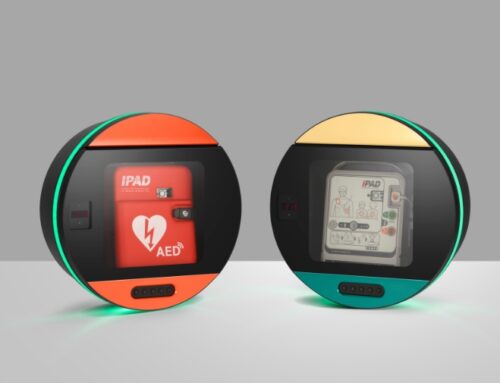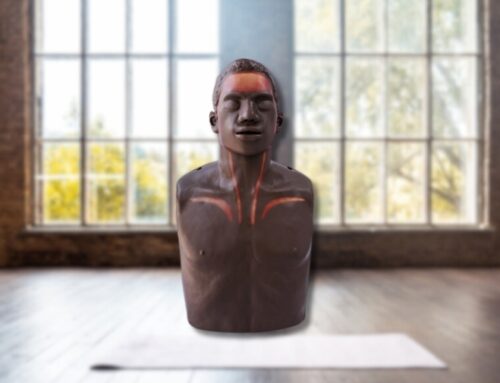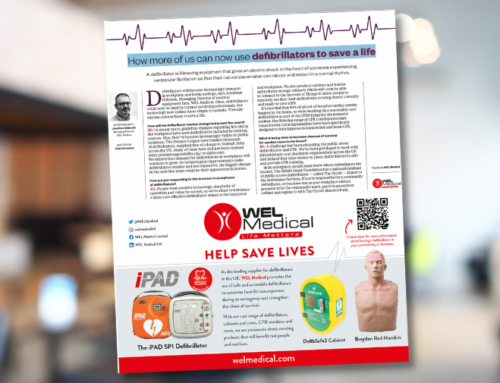[vc_row][vc_column][vc_column_text]Everyone thinks they know what a defibrillator is… but the prospect of actually using one to save someone’s life can bring up all sorts of questions. After all, it’s not a process you want to get wrong!
With that in mind, this is what you need to know about defibrillators, based on ten of the questions we get asked the most.
1. What is the difference between a defibrillator and an AED?
A defibrillator is a piece of lifesaving equipment designed to revive someone from a cardiac arrest by resetting the heart’s sinoatrial node. This node is the heart’s natural pacemaker, and a cardiac arrest happens when it develops an unnatural rhythm that turns into a spasm or flutter. This is called ventricular fibrillation. Contrary to popular belief, defibrillation doesn’t actually restart the heart – it shocks the heart into stopping the fibrillation, so the sinoatrial node can re-establish its natural cadence and restart the heart itself.
An AED is an automated external defibrillator; a type of defibrillator. Unlike the defibs you see on TV shows where an emergency responder uses two paddles on a patient’s chest, an AED uses sticky pads placed on the patient’s upper right chest and lower left abdomen. The unique part of an AED is that it will scan the person’s vitals and determine if they need to be shocked. You can either set the AED to deliver the shock manually, or do so yourself by pressing a button on the unit.
2. How long does a defibrillator last?
This is must-know info about defibs if you own one yourself or are thinking about getting one.
The battery life on defibrillators varies by brand, but the market-leading iPAD SP1 carries a battery life of five years or 200 shocks. The same is also true for our other two models – the iPAD SAVER and our professional lifesaver focused iPAD SP2.
For more information on our defibs, see our guide to choosing the right defibrillator.
3. How do I find my nearest public defibrillator?
When you need a defibrillator, you need one immediately – there is no time to waste. That’s why this is easily one of the most commonly asked questions about defibs.
In that scenario, call 999 and tell them you need to find your nearest defibrillator. They have access to The Circuit, a national defibrillator network people can voluntarily register their defib with. The emergency services will then give you the location of your closest accessible device.
If you own a defibrillator and haven’t registered it with The Circuit yet, you can do so here.
4. How will I know when to use a defibrillator?
[/vc_column_text][vc_empty_space][vc_single_image image=”2576″ img_size=”full”][vc_empty_space][/vc_column][/vc_row][vc_row][vc_column][vc_column_text]We couldn’t write an FAQ giving you everything to know about defibrillators without including this.
When someone collapses, showing no visible signs of life (like Christian Eriksen at the delayed Euro 2020), that is a clear and obvious sign that they have experienced a cardiac arrest and need defibrillation to get their heart restarted.
5. How do I use a Defibrillator?
You should use a defibrillator alongside CPR techniques, closely following the chain of survival.
First, call 999 and request an ambulance plus the location of your nearest AED. Then have one person perform CPR while another retrieves it. If you are on your own, perform CPR to current guidelines until the ambulance crew arrives.
If another person can retrieve an AED, take the defib pads and place them on the casualty’s torso in positions matching the ones indicated on the AED. (Ideally use the included prep razor to remove any hair in those areas before doing so, to give a better contact). The person administering CPR should continue during this whole process.
Once the pads are connected, turn on the unit and follow the prompts given, including when to give breaths and when to pause CPR. The AED will assess the patient for whether a shock is needed. Depending on whether it is an automatic or semi-automatic model, it will then either shock the patient, or request that you press the button to do so.
6. How often should I check and test my defibrillator?
We recommend checking your defib at the very least monthly, but ideally weekly.
On our iPAD SP1 and SP2 models a working unit will show all icons clearly, with no conspicuous gaps on the digital display where an icon should be. If you see a black X on the display instead, contact us immediately.
If your AED indicates it has low battery, change it as soon as possible. Also, be mindful that the electrode pads also have a shelf life. If the pad indicator on your AED is only half full, that means they have only three months left and you should order replacements as soon as possible.
7. Can I use a defibrillator on children/older people?
This is another of the most commonly asked questions about defibs, and we can understand why. After all, when you’re administering an electric shock to someone, you want to know they’re able to take it.
The good news is that yes – you can use a defibrillator on both children and older people. The truth is that it’s almost impossible to severely hurt someone by shocking them – but not doing so during a sudden cardiac arrest dramatically reduces their chances of survival.
For more about administering CPR and defibrillation to children, see our article on exactly that subject.
8. When should I take the defib pads off someone who has been successfully revived?
You shouldn’t. A person recently revived from a cardiac arrest is still in an incredibly vulnerable position and may be susceptible to another cardiac event. Indeed, that was the case for Charlotte Pickwick in our recent lifesaving festive stories piece, who went into cardiac arrest twice more after being first revived. Thankfully, the story had a happy ending for all concerned.
We recommend keeping the pads on a cardiac arrest victim and waiting until the ambulance services arrive.[/vc_column_text][vc_empty_space height=”16px”][vc_single_image image=”2709″ img_size=”full”][vc_empty_space height=”16px”][vc_column_text]
9. Can a defibrillator be used in the rain?
Yes! As mentioned in our blog post busting common defibrillator myths, using a defib near water does not put the person being shocked at risk of electrocution. We would certainly suggest moving the casualty away from any standing bodies of water for sheer ease of usability. And if it’s throwing it down with rain, you may also want to move them to nearby shelter.
Having said that, one of the pieces of must-know info about defibs is that every moment spent without CPR and defibrillation lowers a casualty’s survival chances by 10%. So please don’t spend too long finding the perfect location – it’s okay to use a defib in the rain.
Lifesaving technology designed for everyone
At WEL Medical, we believe that lifesaving technology like defibrillators should be accessible for all. We work hard to provide industry-leading products at an affordable price, to people from all walks of life. And while a defibrillator can be used without specialist training, we’re always happy to organise a special training event for anyone taking on one or more of our units.
To learn more about defibrillators and why you need one in your local community, company or service, read the blogs below and get in touch to secure your defib today.[/vc_column_text][vc_empty_space][/vc_column][/vc_row][vc_row][vc_column][vc_column_text]
Related articles
- Choosing the Right Defibrillator
- What Happens When You Use A Defibrillator?
- World First Aid Day: CPR Guidance in a Covid-19 World
- Defibrillator Myths Busted
- Christmas Miracles: Lifesaving Festive Stories
[/vc_column_text][/vc_column][/vc_row]





